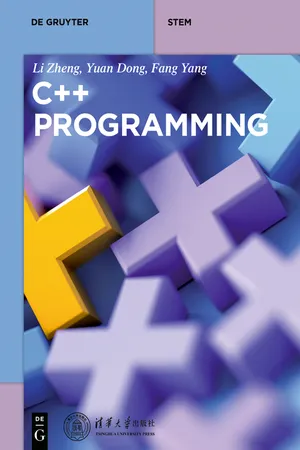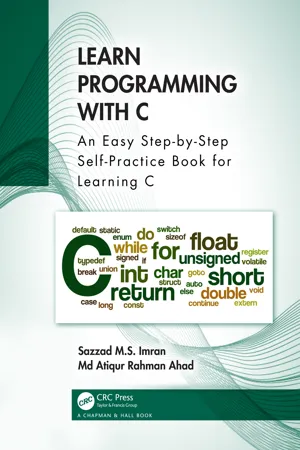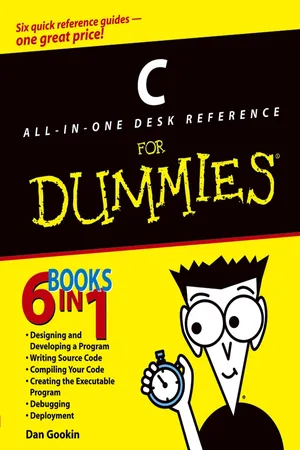Computer Science
C Functions
C functions are blocks of code that perform a specific task and can be called from other parts of a program. They help in organizing code, making it more modular and easier to maintain. Functions in C can take input parameters, perform operations, and return results, providing a way to encapsulate and reuse code.
Written by Perlego with AI-assistance
Related key terms
1 of 5
7 Key excerpts on "C Functions"
- eBook - ePub
Learn C Programming from Scratch
A step-by-step methodology with problem solving approach (English Edition)
- Mohammad Saleem Mir(Author)
- 2024(Publication Date)
- BPB Publications(Publisher)
HAPTER 4Functions IntroductionFunctions in C programming are blocks of code that perform specific tasks. They are also known as modules , routines, procedures, and sub-programs. They offer means of breaking down a program into smaller, more manageable pieces of code. They promote modularity, code reusability, and enhance program organization. Functions can be built-in, user-defined, or part of external libraries. They have a well-defined structure, which includes a function prototype and a function definition, clearly mentioning return type and parameters . Function prototypes are used to declare functions in advance. Recursion is a powerful concept in C, where a function calls itself to solve complex problems. Understanding function variable scope is important, with local variables being limited to a specific block and global variables accessible across functions.Structure In this chapter, we will cover the following topics:- Functions
- Scope of variables in functions
- Recursion
- Callback functions
The objective of this chapter is to provide an understanding of functions in C programming. It covers function declaration, definition, calling, return statements, parameters, variable scope, and recursion. By the end of this chapter, readers will have a solid foundation in using functions effectively to structure their code, improve code organization, and solve complex problems using recursion.FunctionsA function is a module or a sub-program containing a group of statements that perform a specific task. A C program may consist of one or more functions; however, if there is only one function in a C program, it must be main() - eBook - ePub
- Yuan Dong, Fang Yang, Li Zheng(Authors)
- 2019(Publication Date)
- De Gruyter(Publisher)
3FunctionsC++ inherits all the C syntax, including the definition and usage of functions. In process-oriented programming (also known as structured programming), function is the basic unit of module division, and an abstract of the problem-solving process. Function is also important in object-oriented programming, in which it is an abstract of functionalities.To develop or debug a complex system, engineers will usually divide it into several subsystems, and then develop or debug based on these subsystems. Subprograms in high-level program languages are used to realize this kind of module division. In C and C++, subprograms are embodied as functions. We usually abstract functions from independent and frequently used functionality modules. Once a function is written, we can reuse it only knowing its functions and usage, without needing to know its specific implementation. In this way code is reused, development efficiency and program reliability are improved, and collaboration, modification, and maintenance can be realized more easily.3.1Definition and Use of Function
A C++ program consists of one main function and several subfunctions. A program is executed starting from its main function. The main function may call subfunctions, and subfunctions may in turn call other subfunctions.The function that calls other functions is named a “calling function ”, and the function called by others is named a “called function ”. A function may call another function and also be called by another. Thus it can be a calling function in one occasion and a called function in another.3.1.1Definition of Function
1.Syntax form of function definition
2.Type of function and return value
The type identifier defines the type of the function, and also the type of the return value of the function. The return value of the function is the result that the function returns to its calling function, which is given by a return statement, such as “return 0 - eBook - PDF
- Subrata Saha, Subhodip Mukherjee(Authors)
- 2017(Publication Date)
- Cambridge University Press(Publisher)
Library functions are defined within several header files as per individual category of the functions. We already discussed some library functions and some other will be discussed later. Though C supports a large number of library functions, but this is not sufficient. According to our requirement we need to define our own functions. These are called user defined function . In this chapter we will discuss how a user defined function can be defined and how it can be accessed, etc. Basically, any C program is a collection of one or more functions. If it contains only one function, then it is the main function. In C program main function is a special function. Every C program starts its execution from main function and other functions are called from this function as well. Every C program must have a main function and more than one main function is not possible in a single program. However, a C program may contain more than one user defined function and there is no restriction on this. If more than one function is present in a C program, they may appear in any sequence. Though there are many other functions, we can understand the basic logic of the program by reading only the main function. It is the heart of the program as the control flow of the program is totally under the control of this main function. 13.1 WHY FUNCTION Till now whatever programs we wrote are very small and simple. But in real life, it is not that easier. Rather they are large enough and quite complicated. As programs become more complex and large, several problems may arise. It is always better to handle some smaller programs than a large one. That is why the modular programming concept arises – where Function Function 321 a large program is divided into some smaller modules. In C programming, these modules are known as functions. There are several advantages of use of functions. These are: Increases readability: Functions are used to split up long lines of code into smaller ones called modules. - eBook - ePub
Learn Programming with C
An Easy Step-by-Step Self-Practice Book for Learning C
- Sazzad M.S. Imran, Md Atiqur Rahman Ahad(Authors)
- 2024(Publication Date)
- Chapman and Hall/CRC(Publisher)
CHAPTER 4 FunctionsDOI: 10.1201/9781003302629-4A FUNCTION IS A SET of statements that performs a specific task. Every C program must have at least one main() function, but any additional functions can be defined and used. This chapter presents and discusses two types of functions: library and user-defined.4.1 FUNCTION TYPES
When we need to execute a block of statements several times, we define a function that contains those statements and call it every time we need it. Functions are used to make the codes more readable and reusable. In C, there are two different types of functions.- Library functions: The standard library functions are predefined in the library (.lib) and declared in several header files (.h). We can call these functions anytime we need to do the task that that function defines. printf(), scanf(), gets(), puts(), etc., are some examples. Because functions printf() and scanf() are declared in the stdio.h header file, the header file must be included before they can be called in a C program using the preprocessor directive #include. Example is #include stdio.h>
- User-defined functions: These functions are defined by the programmer and afterward reused as needed.
4.2 FUNCTION STRUCTURE
Syntax of the C Functions: return_type function_name(argument_list){ //blocks of valid C statements } return_type can be any valid data type like int, char, long int, float, double, etc. It can also be void if the function returns nothing. Except for any keywords, function name can be any single alphanumeric word, preferably meaningful.argument_list is a list of variables and their data types that are passed to the function as input. The formal parameter refers to the parameters that appear in the function declaration, whereas the actual parameter refers to the parameters that appear in the function call.For example, the following function takes two floating numbers, a and b, as its arguments and returns the total a+b. Here, a and b are the formal parameters, whereas x and y are the real parameters in the addition(x, y) function call. - eBook - ePub
C Programming
Learn to Code
- Sisir Kumar Jena(Author)
- 2021(Publication Date)
- Chapman and Hall/CRC(Publisher)
Suppose you have a large task to do. The usual procedure is to divide the task into smaller tasks, solve each one separately, and combine them to solve the bigger problem. This process is called modular programming, and modular programming employs the concept of functions. After we divide the whole task into subproblems, each subproblem can be implemented with a function. Combining the result of all functions, we can solve a bigger problem. Consider the problem of designing a calculator. A calculator performs many tasks like addition, subtraction, multiplication, and square roots. We can write code for each task using a separate function and call them with the main() function to solve a bigger task. Figure 9.4 shows the modular division of tasks for a calculator design. Figure 9.4 Modular design of the task and each task employed with a function. The advantage of using functions is: Modular programming; Reduction in the amount of work and development time; Program and function debugging are easier; Reduction in size of the program; Reuse of code. 9.3 Types of Function The C programming language supports two types of functions: Library functions or predefined functions; User-defined functions. We have come across many library functions like printf() and scanf() which were used in our previous programs, and the definition of these functions are predefined. In the following section, we are going to discuss user-defined functions. The basic difference between these two types of function is that we do not write library functions; we only use them, whereas we write user-defined functions for specific problems. 9.4 User-defined Functions A function can be defined as a group of statements enclosed within a block with a valid identifier and can perform a specific task. Generally, a function will process information that is passed to it from the calling portion of the program and return a single value - eBook - ePub
- Dan Gookin(Author)
- 2011(Publication Date)
- For Dummies(Publisher)
Chapter 5: Creating Your Own Functions
In This Chapter
Writing your own functions in CUsing functions in CPrototyping functionsWorking with variables inside functionsUnderstanding local and global variablesPassing values to functionsReturning a value from a functionAvoiding the function prototypeT he C language is composed of keywords, operators, variables — blah, blah, blah — and functions. If you have done any C programming at all, you have already used many functions: printf() , getchar() , scanf() , strcpy() , and the lot. All told, the C language and all its libraries have hundreds of functions that do many various and miraculous things for you. But they don’t do everything.To cover all the bases, you can create your own functions in C. These functions are created using the C language and they work just like the C language library functions. You can use your own functions to optimize your source code, carry out repetitive tasks, or just because. The function can do anything you want, as long as you read through this chapter and understand how to do functions in C.Your Typical Function
It’s entirely possible to code without functions. But it’s also an insane thing to do. At some point, you rewrite the same chunk of code over and over. It may be a long chunk of code, or something tiny. But you have to copy and paste and soon your source code is five or seven screens long.I’m fond of saying that when things look redundant or awkward in your C language source code that a better way of programming looms on the horizon. This is especially true with repetitive code, and possibly the motivation for early programmers in the 1950s to dream up the function — or procedure or subroutine , as it’s called in other programming languages.Some functions optimize code. Some merely hide the dirty work to keep the main part of the program clean. Some functions produce output. Some functions require input. And some functions do neither input nor output. It’s all up to the programmer who created the function. - eBook - ePub
Embedded Software
The Works
- Colin Walls(Author)
- 2012(Publication Date)
- Newnes(Publisher)
prototype for subsequent use of the function. Function declaration is optional in C (unlike C++ where it is mandatory). For example:int my_function(int, char);• Defining a function is the task of writing the program code that makes up the function. For example:int my_function(int x, char c) { … if (c=='y') return (x*47); … }• Calling a function involves its actual use as a program element, either from other functions or, in the case of recursion, from the function itself. For example:z=my_function(22, 'y');4.2.1 Before Prototypes
Function prototypes are an extension to the optional declaration of C Functions. In the original K&R definition of C, only the return type of functions could be declared before actually defining or using the function, as follows:return_type my_function(); where return_type is the data type returned by the function. In the absence of return_type , function type defaults to int . This seems odd, because void is a more logical choice. However, void was not included in the language standard until ANSI, so there were backward compatibility issues.Note that such a declaration causes the compiler to check the return assignment of a function but makes no effort to check the types of parameters passed in a call to that function. In the absence of such parameter “prototypes,” the compiler generates code assuming that all parameters are correct, leading to errors that are difficult to diagnose at runtime.4.2.2 Applying Prototypes
Function prototypes extend function declaration to include the formal parameters. For example, if the my_function() function, discussed in the previous section, requires two integer parameters, the declaration could be expressed as follows:return_type my_function(int x, y); where int x, y indicates that the function requires two parameters, both of which are integers. Note that the variable names x and y
Index pages curate the most relevant extracts from our library of academic textbooks. They’ve been created using an in-house natural language model (NLM), each adding context and meaning to key research topics.






